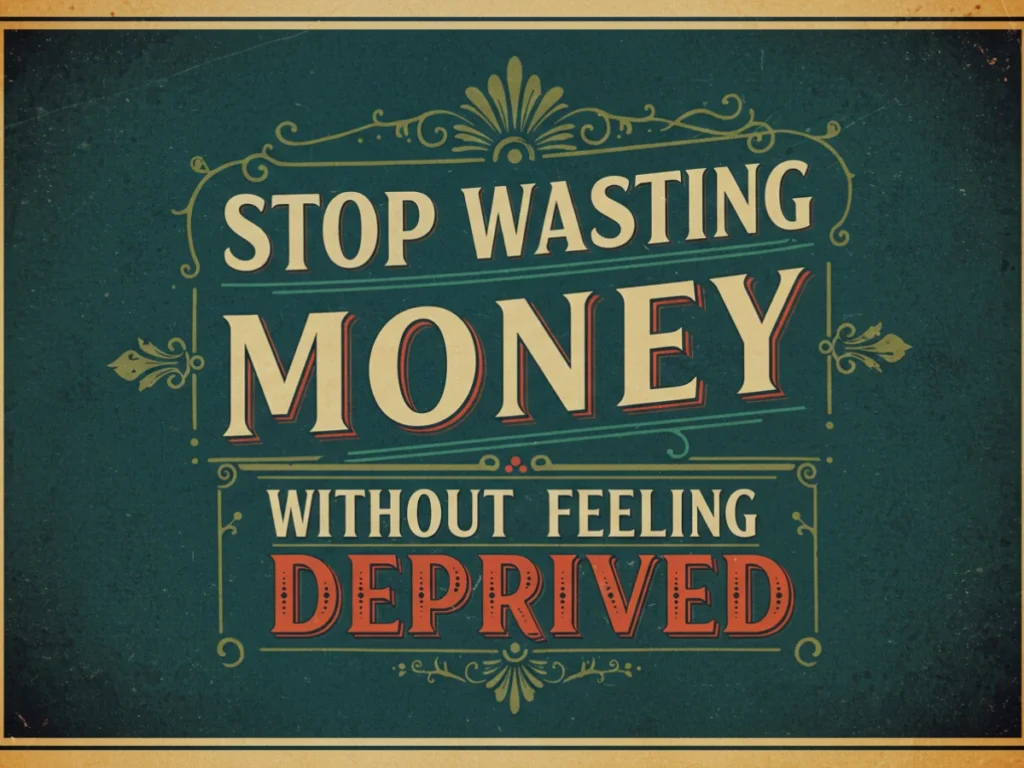I used to feel stuck. I wanted to save money, but every time I tried to cut back, it felt like I had to give up all the fun stuff. No snacks, no outings, no shopping — just rules. It made me feel miserable, and honestly, I’d quit after a week.
Then I learned something important: you can stop wasting money without feeling deprived. It doesn’t mean you can’t spend at all — it just means you spend smarter. Over time, I figured out how to keep the things I enjoy, while still saving a lot more money. Here’s how I did it — no strict budgets, no guilt, just small changes that made a big difference.
1. I Started Noticing My “Invisible Spending”

One of the first things I did was take a look at where my money was actually going. I realized I had what I call “invisible spending” — small amounts that disappeared without me thinking.
Like:
- $2 here for snacks from a vending machine
- $5 on apps I forgot I even downloaded
- $10 subscriptions I never used
It didn’t feel like I was wasting money, but when I added it up, I was shocked. These little things were costing me $20–$50 every week.
Fix: I took 15 minutes to check my bank app and cancel anything I wasn’t using — streaming services, game subscriptions, cloud storage, you name it. I also made a rule: no buying snacks with coins unless I had planned it. I didn’t feel deprived — I just finally saw where my money was going.
2. I Made a “Yes List” Instead of a “No List”
Budgeting used to feel like a list of rules:
❌ No fast food
❌ No shopping
❌ No coffee
It felt like I was always saying “no.”
So I flipped it around. I made a “Yes List.” This was a list of the things I could spend money on, guilt-free. It included:
- One coffee out per week
- Dinner with friends once a month
- $20 a month for something fun
This made things easier. I didn’t feel like I was giving up everything — I just focused on saying “yes” to things that truly mattered.
Fix: Try writing down the stuff you actually love — then cut out the extras that you don’t even enjoy that much. You’ll spend less without feeling like you’re missing out.
3. I Delayed Purchases (But Didn’t Say “No”)
Here’s a simple trick that helped me a lot: I waited before buying stuff. When I saw something I liked online — a hoodie, a phone case, whatever — I added it to a list instead of clicking “Buy Now.”
Then I waited 48 hours. Most of the time, I forgot about it. If I still wanted it after two days, I gave myself permission to get it. Often, I didn’t.
Fix: Use a “wait list” or even just write it down on paper. Waiting gives you space to think clearly. You might find out that it wasn’t worth your money after all.
4. I Made Fun Plans That Cost Less
Before, my fun plans usually meant spending money — movie nights, fast food runs, shopping trips. They added up fast.
Instead, I started looking for things that were just as fun but didn’t cost as much. A few things I started doing:
- Hosting game nights at home
- Walks or bike rides with friends
- Movie night with popcorn at home
Fix: You don’t have to give up fun — just get creative with it. Ask your friends to bring snacks instead of going out. Find free events in your area. Fun doesn’t have to be expensive.
5. I Cooked Simple Meals at Home
I’m not a chef or anything, but eating out was killing my wallet. One burger meal could cost $12. So I started learning to cook simple meals — nothing fancy. Sandwiches, pasta, rice bowls. I even learned to make my own iced coffee at home.
By bringing my own lunch and eating more at home, I was saving at least $50 a week.
Fix: Pick 2–3 easy meals you enjoy and learn to make them. Make enough to have leftovers. It’s cheaper, and you get to eat what you actually like.
6. I Unfollowed Temptation
I used to scroll through shopping sites or follow influencers who always posted new clothes, gadgets, or makeup. Even if I wasn’t looking to buy, I’d end up spending money. That’s the power of marketing.
So I unfollowed those accounts and deleted some shopping apps from my phone. It wasn’t forever — just long enough for me to stop feeling tempted.
Fix: Clean up your social media feed and phone. If it’s not in front of you, you won’t want it as much. Out of sight, out of cart.
7. I Used the “One Fun, One Free” Rule
This was a simple rule I made for myself:
If I spend money on one fun thing this week, I also have to do one fun thing that’s free.
For example:
🎬 Friday movie night with friends = 💸
🌳 Saturday walk in the park = free
This helped me balance spending and still feel like I was having a good time.
Fix: Pair paid activities with free ones. It makes your week feel full and saves money at the same time.
8. I Used Cash for “Extra” Spending
Instead of using my card for everything, I started pulling out $40 cash at the start of the week for “extras” — snacks, outings, etc. When the cash ran out, that was it for the week.
Using real money made me think twice before spending. It’s easy to swipe a card without feeling the cost, but handing over cash? That felt real.
Fix: Set a weekly spending limit in cash for your “fun money.” It helps you stay in control without needing a full budget plan.
9. I Learned the Difference Between Want and Need
Before I buy something now, I ask myself a simple question:
“Do I really need this, or do I just want it right now?”
This tiny habit helped me avoid so many impulse buys. It didn’t mean I never got things I wanted — but it helped me spend with purpose.
Fix: Pause before buying. Ask yourself:
- Will I still want this next week?
- Do I already have something similar?
- Is this the best way to use my money?
You’ll be surprised how often the answer is no.
10. I Celebrated My Wins (Big or Small)
Saving money is hard when it feels like punishment. So I decided to celebrate every little win. Brought lunch all week? I’d treat myself to a coffee. Skipped a shopping trip? I’d watch a movie at home with popcorn. Hit my savings goal? I’d take a day off from tracking.
Fix: Make saving feel like progress, not punishment. Reward yourself in smart ways. Even a simple “nice job” to yourself can keep you motivated.
Final Thoughts
Stopping wasteful spending doesn’t mean you have to live like a robot. I still eat out sometimes. I still treat myself. The difference is I do it on purpose, not out of habit.
Once I started spending more mindfully, I didn’t feel deprived — I felt in control. That’s a good feeling. It’s not about cutting out everything fun. It’s about choosing what’s really worth it.
If you want to save more money but hate the idea of feeling restricted, try just a few of these habits. You’ll spend less, feel better, and maybe even enjoy life more than before.
And trust me — you don’t have to be perfect. Just start small, and watch your money stay where it belongs: with you.
Check this out:
How to Launch a Cleaning Business and Earn £500,000 Annually
Starting a Vending Machine Side Hustle: Steps to Achieve $900 Monthly Income
A Guide to Profitable Reselling Businesses: From Zero to $20,000 a Month
